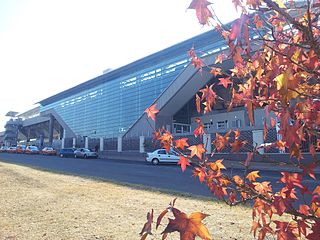This article needs additional citations for verification .(December 2009) (Learn how and when to remove this template message) |
Prinshof | |
|---|---|
 Prinshof | |
| Coordinates: 25°44′02″S28°11′56″E / 25.734°S 28.199°E Coordinates: 25°44′02″S28°11′56″E / 25.734°S 28.199°E | |
| Country | South Africa |
| Province | Gauteng |
| Municipality | City of Tshwane |
| Main Place | Pretoria |
| Area | |
| • Total | 1.46 km2 (0.56 sq mi) |
| Population (2011) [1] | |
| • Total | 2,970 |
| • Density | 2,000/km2 (5,300/sq mi) |
| Racial makeup (2011) | |
| • Black African | 71.6% |
| • Coloured | 4.9% |
| • Indian/Asian | 2.1% |
| • White | 20.9% |
| • Other | 0.5% |
| First languages (2011) | |
| • English | 15.6% |
| • Northern Sotho | 15.3% |
| • Afrikaans | 15.1% |
| • Tswana | 10.2% |
| • Other | 43.9% |
| Time zone | UTC+2 (SAST) |
Prinshof is an area in Pretoria. It is the home of the Faculty of Health Sciences of the University of Pretoria and the Steve Biko Hospital (formerly the Pretoria Academic Hospital).

Pretoria is a city in the northern part of Gauteng province in South Africa. It straddles the Apies River and has spread eastwards into the foothills of the Magaliesberg mountains. It is one of the country's three capital cities, serving as the seat of the administrative branch of government, and of foreign embassies to South Africa. Pretoria has a reputation for being an academic city with three universities, the Council for Scientific and Industrial Research (CSIR) and the Human Sciences Research Council. The city also hosts the National Research Foundation and the South African Bureau of Standards making the city a hub for research. Pretoria is the central part of the Tshwane Metropolitan Municipality which was formed by the amalgamation of several former local authorities including Centurion and Soshanguve. There have been proposals to change the name of Pretoria itself to Tshwane, and the proposed name change has caused some public controversy.

The University of Pretoria is a multi-campus public research university in Pretoria, the administrative and de facto capital of South Africa. The university was established in 1908 as the Pretoria campus of the Johannesburg-based Transvaal University College and is the fourth South African institution in continuous operation to be awarded university status. The university has grown from the original 32 students in a single late Victorian house to approximately 39,000 in 2010. The University was built on 7 suburban campuses on 1,120 hectares.
Prinshof is also the name of a school in Pretoria for partially sighted children.













